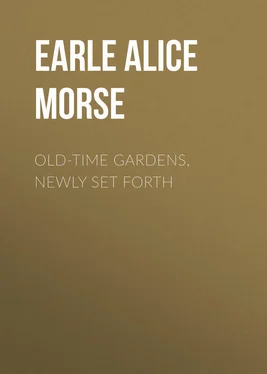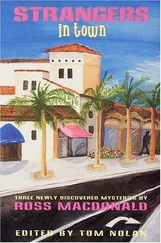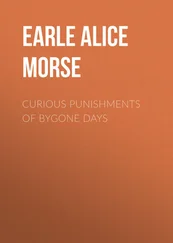Alice Earle - Old-Time Gardens, Newly Set Forth
Здесь есть возможность читать онлайн «Alice Earle - Old-Time Gardens, Newly Set Forth» — ознакомительный отрывок электронной книги совершенно бесплатно, а после прочтения отрывка купить полную версию. В некоторых случаях можно слушать аудио, скачать через торрент в формате fb2 и присутствует краткое содержание. Жанр: foreign_antique, foreign_prose, на английском языке. Описание произведения, (предисловие) а так же отзывы посетителей доступны на портале библиотеки ЛибКат.
- Название:Old-Time Gardens, Newly Set Forth
- Автор:
- Жанр:
- Год:неизвестен
- ISBN:нет данных
- Рейтинг книги:3 / 5. Голосов: 1
-
Избранное:Добавить в избранное
- Отзывы:
-
Ваша оценка:
- 60
- 1
- 2
- 3
- 4
- 5
Old-Time Gardens, Newly Set Forth: краткое содержание, описание и аннотация
Предлагаем к чтению аннотацию, описание, краткое содержание или предисловие (зависит от того, что написал сам автор книги «Old-Time Gardens, Newly Set Forth»). Если вы не нашли необходимую информацию о книге — напишите в комментариях, мы постараемся отыскать её.
Old-Time Gardens, Newly Set Forth — читать онлайн ознакомительный отрывок
Ниже представлен текст книги, разбитый по страницам. Система сохранения места последней прочитанной страницы, позволяет с удобством читать онлайн бесплатно книгу «Old-Time Gardens, Newly Set Forth», без необходимости каждый раз заново искать на чём Вы остановились. Поставьте закладку, и сможете в любой момент перейти на страницу, на которой закончили чтение.
Интервал:
Закладка:
Sometimes a graceful and picturesque growth of vines will beautify gate posts, a fence, or a kitchen doorway in a wonderfully artistic and pleasing fashion. On page 70 is shown the sheltered doorway of the kitchen of a fine old stone farm-house called, from its hedges of Osage Orange, "The Hedges." It stands in the village of New Hope, County Bucks, Pennsylvania. In 1718 the tract of which this farm of over two hundred acres is but a portion was deeded by the Penns to their kinsman, the direct ancestor of the present owner, John Schofield Williams, Esq. This is but one of the scores of examples I know where the same estate has been owned in one family for nearly two centuries, sometimes even for two hundred and fifty years; and in several cases where the deed from the Indian sachem to the first colonist is the only deed there has ever been, the estate having never changed ownership save by direct bequest. I have three such cases among my own kinsfolk.
Another form of garden and mode of planting which was in vogue in the "early thirties" is shown facing page 92. This pillared house and the stiff garden are excellent types; they are at Napanock, County Ulster, New York. Such a house and grounds indicated the possession of considerable wealth when they were built and laid out, for both were costly. The semicircular driveway swept up to the front door, dividing off Box-edged parterres like those of the day of Queen Anne. These parterres were sparsely filled, the sunnier beds being set with Spring bulbs; and there were always the yellow Day Lilies somewhere in the flower beds, and the white and blue Day Lilies, the common Funkias. Formal urns were usually found in the parterres and sometimes a great cone or ball of clipped Box. These gardens had some universal details, they always had great Snowball bushes, and Syringas, and usually white Roses, chiefly Madame Plantiers; the piazza trellises had old climbing Roses, the Queen of the Prairie or Boursault Roses. These gardens are often densely overshadowed with great evergreen trees grown from the crowded planting of seventy years ago; none are cut down, and if one dies its trunk still stands, entwined with Woodbine. I don't know that we would lay out and plant just such a garden to-day, any more than we would build exactly such a house; but I love to see both, types of the refinement of their day, and I deplore any changes. An old Southern house of allied form is shown on page 72, and its garden facing page 70, – Greenwood, in Thomasville, Georgia; but of course this garden has far more lavish and rich bloom. The decoration of this house is most interesting – a conventionalized Magnolia, and the garden is surrounded with splendid Magnolias and Crape Myrtles. The border edgings in this garden are lines of bricks set overlapping in a curious manner. They serve to keep the beds firmly in place, and the bricks are covered over with an inner edging of thrifty Violets. Curious tubs and boxes for plants are made of bricks set solidly in mortar. The garden is glorious with Roses, which seem to consort so well with Magnolias and Violets.
I love a Dutch garden, "circummured" with brick. By a Dutch garden, I mean a small garden, oblong or square, sunk about three or four feet in a lawn – so that when surrounded by brick walls they seem about two feet high when viewed outside, but are five feet or more high from within the garden. There are brick or stone steps in the middle of each of the four walls by which to descend to the garden, which may be all planted with flowers, but preferably should have set borders of flowers with a grass-plot in the centre. On either side of the steps should be brick posts surmounted by Dutch pots with plants, or by balls of stone. Planted with bulbs, these gardens in their flowering time are, as old Parkinson said, a "perfect fielde of delite." We have very pretty Dutch gardens, so called, in America, but their chief claim to being Dutch is that they are set with bulbs, and have Delft or other earthen pots or boxes for formal plants or shrubs.
Sunken gardens should be laid out under the supervision of an intelligent landscape architect; and even then should have a reason for being sunken other than a whim or increase in costliness. I visited last summer a beautiful estate which had a deep sunken Dutch garden with a very low wall. It lay at the right side of the house at a little distance; and beyond it, in full view of the peristyle, extended the only squalid objects in the horizon. A garden on the level, well planted, with distant edging of shrubbery, would have hidden every ugly blemish and been a thing of beauty. As it is now, there can be seen from the house nothing of the Dutch garden but a foot or two of the tops of several clipped trees, looking like very poor, stunted shrubs. I must add that this garden, with its low wall, has been a perfect man-trap. It has been evident that often, on dark nights, workmen who have sought a "short cut" across the grounds have fallen over the shallow wall, to the gardener's sorrow, and the bulbs' destruction. Once, at dawn, the unhappy gardener found an ancient horse peacefully feeding among the Hyacinths and Tulips. He said he didn't like the grass in his new pasture nor the sudden approach to it; that he was too old for such new-fangled ways. I know another estate near Philadelphia, where the sinking of a garden revealed an exquisite view of distant hills; such a garden has reason for its form.
We have had few water-gardens in America till recent years; and there are some drawbacks to their presence near our homes, as I was vividly aware when I visited one in a friend's garden early in May this year. Water-hyacinths were even then in bloom, and two or three exquisite Lilies; and the Lotus leaves rose up charmingly from the surface of the tank. Less charmingly rose up also a cloud of vicious mosquitoes, who greeted the newcomer with a warm chorus of welcome. As our newspapers at that time were filled with plans for the application of kerosene to every inch of water-surface, such as I saw in these Lily tanks, accompanied by magnified drawings of dreadful malaria-bearing insects, I fled from them, preferring to resign both Nymphæa and Anopheles .
After the introduction to English folk of that wonder of the world, the Victoria Regia, it was cultivated by enthusiastic flower lovers in America, and was for a time the height of the floral fashion. Never has the glorious Victoria Regia and scarce any other flower been described as by Colonel Higginson, a wonderful, a triumphant word picture. I was a very little child when I saw that same lovely Lily in leaf and flower that he called his neighbor; but I have never forgotten it, nor how afraid I was of it; for some one wished to lift me upon the great leaf to see whether it would hold me above the water. We had heard that the native children in South America floated on the leaves. I objected to this experiment with vehemence; but my mother noted that I was no more frightened than was the faithful gardener at the thought of the possible strain on his precious plant of the weight of a sturdy child of six or seven years. I have seen the Victoria Regia leaves of late years, but I seldom hear of its blossoming; but alas! we take less heed of the blooming of unusual plants than we used to thirty or forty years ago. Then people thronged a greenhouse to see a new Rose or Camellia Japonica; even a Night-blooming Cereus attracted scores of visitors to any house where it blossomed. And a fine Cactus of one of our neighbors always held a crowded reception when in rich bloom. It was a part of the "Flower Exchange," an interest all had for the beautiful flowers of others, a part of the old neighborly life.
Within the past five or six years there have been laid out in America, at the country seats of men of wealth and culture, a great number of formal gardens, – Italian gardens, some of them are worthily named, as they have been shaped and planted in conformity with the best laws and rules of Italian garden-making – that special art. On this page is shown the finely proportioned terrace wall, and opposite the upper terrace and formal garden of Drumthwacket, Princeton, New Jersey, the country seat of M. Taylor Pyne, Esq. This garden affords a good example of the accord which should ever exist between the garden and its surroundings. The name, Drumthwacket – a wooded hill – is a most felicitous one; the place is part of the original grant to William Penn, and has remained in the possession of one family until late in the nineteenth century. From this beautifully wooded hill the terrace-garden overlooks the farm buildings, the linked ponds, the fertile fields and meadows; a serene pastoral view, typical of the peaceful landscape of that vicinity – yet it was once the scene of fiercest battle. For the Drumthwacket farm is the battle-ground of that important encounter of 1777 between the British and the Continental troops, known as the Battle of Princeton, the turning point of the Revolution, in which Washington was victorious. To this day, cannon ball and grape shot are dug up in the Drumthwacket fields. The Lodge built in 1696 was, at Washington's request, the shelter for the wounded British officers; and the Washington Spring in front of the Lodge furnished water to Washington. The group of trees on the left of the upper pond marks the sheltered and honored graves of the British soldiers, where have slept for one hundred and twenty-four years those killed at this memorable encounter. If anything could cement still more closely the affections of the English and American peoples, it would be the sight of the tenderly sheltered graves of British soldiers in America, such as these at Drumthwacket and other historic fields on our Eastern coast. At Concord how faithfully stand the sentinel pines over the British dead of the Battle of Concord, who thus repose, shut out from the tread of heedless feet yet ever present for the care and thought of Concord people.
Читать дальшеИнтервал:
Закладка:
Похожие книги на «Old-Time Gardens, Newly Set Forth»
Представляем Вашему вниманию похожие книги на «Old-Time Gardens, Newly Set Forth» списком для выбора. Мы отобрали схожую по названию и смыслу литературу в надежде предоставить читателям больше вариантов отыскать новые, интересные, ещё непрочитанные произведения.
Обсуждение, отзывы о книге «Old-Time Gardens, Newly Set Forth» и просто собственные мнения читателей. Оставьте ваши комментарии, напишите, что Вы думаете о произведении, его смысле или главных героях. Укажите что конкретно понравилось, а что нет, и почему Вы так считаете.












